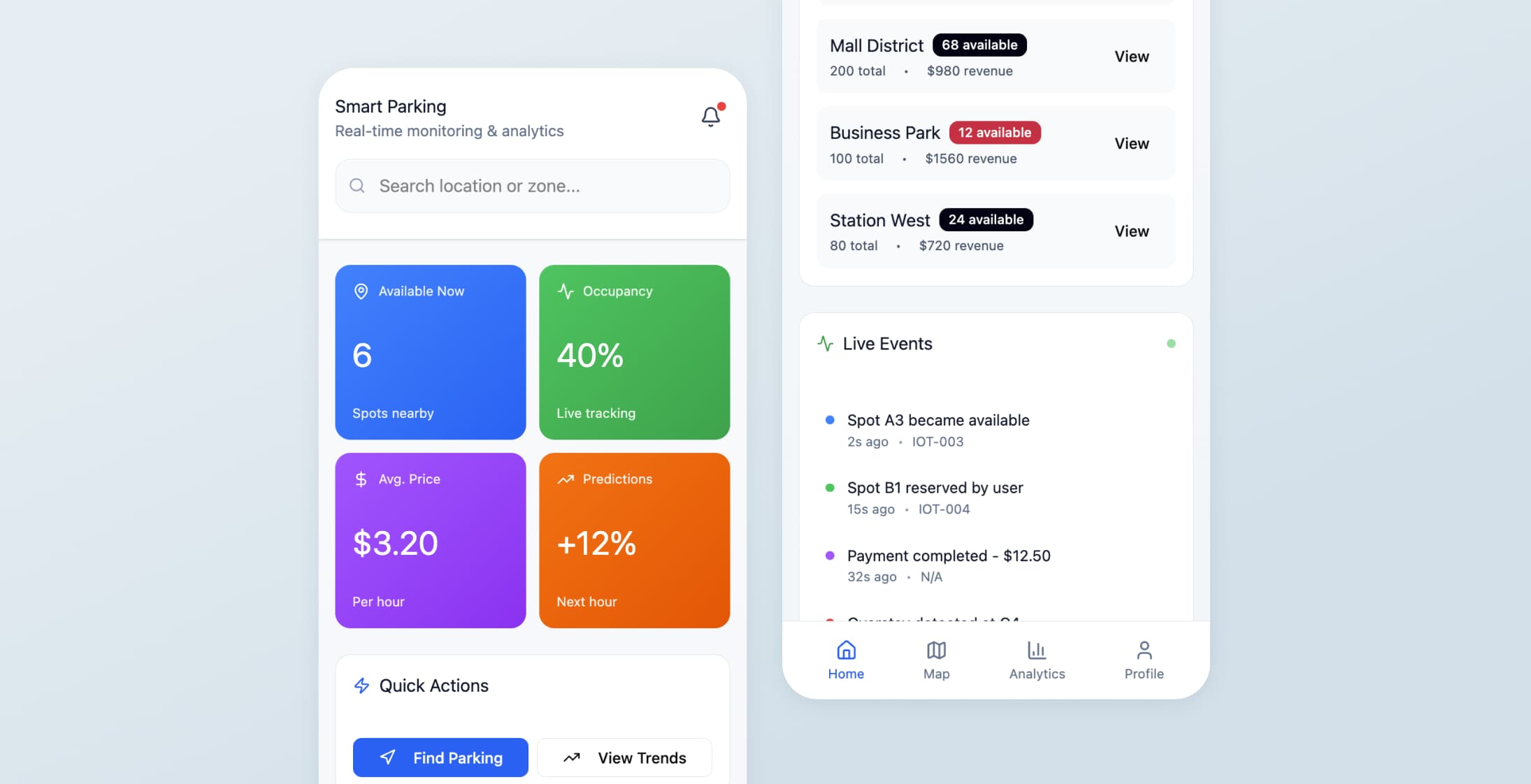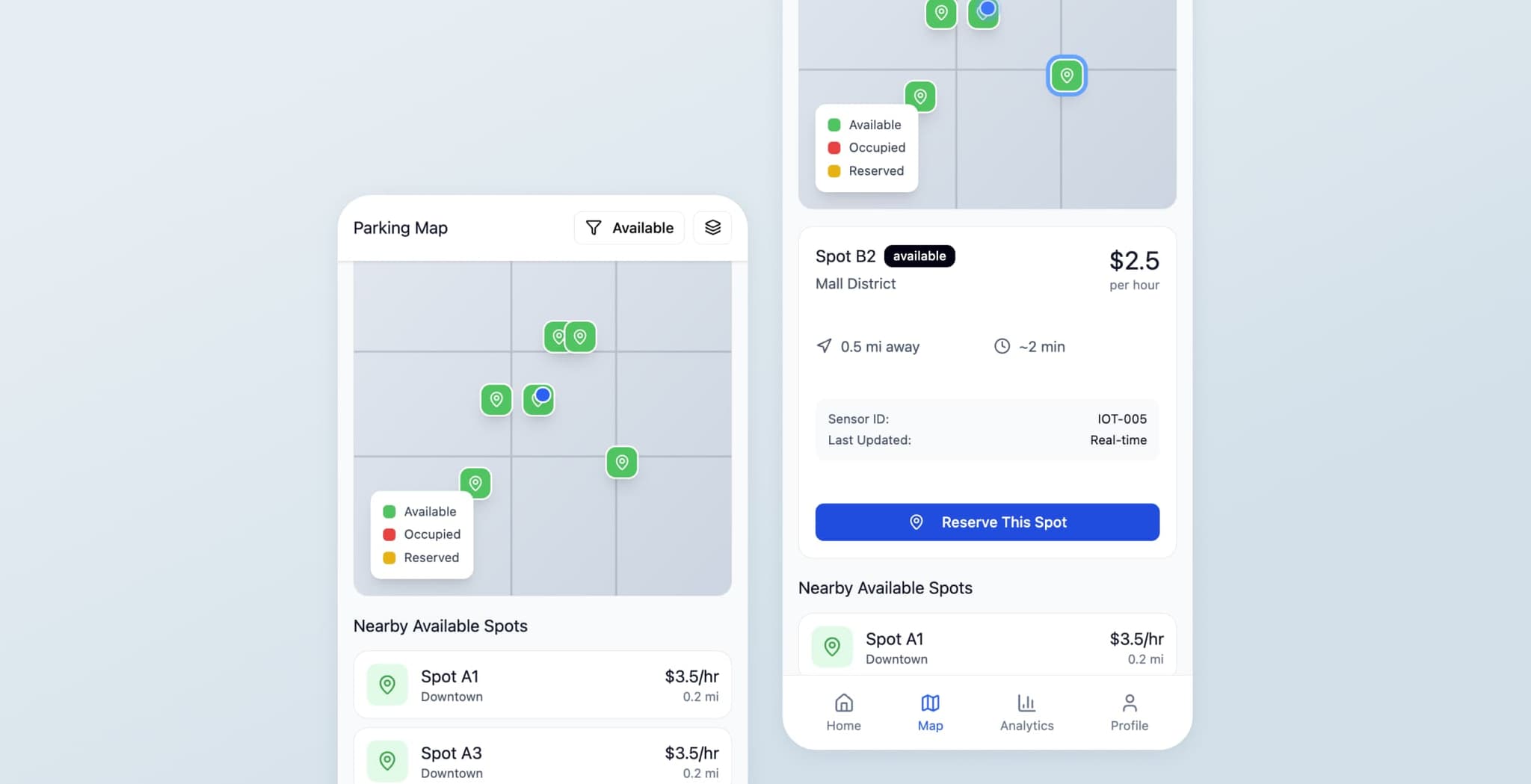

Project Overview
Urban parking inefficiencies have led to a range of issues such as traffic jams on the roads and higher fuel wastage. This has also impacted the revenue for those overseeing parking spaces in city areas.
An all-in-one mobility system that combines real-time sensor networks and predictive analytics alongside automated payment processing has slashed parking search times by 68% while boosting space utilization rates by 43%.
Revenue enhancement algorithms and flexible pricing strategies raised operator profits by 31% while cutting down on costs through automated enforcement and maintenance scheduling.
The system utilized edge computing and event-based messaging within its platform architecture to handle more than 2.5 million parking occurrences on a daily basis across a total of 15,000 monitored parking spaces.
The Urban Parking Challenge
Urban parking poses an infrastructure challenge in city areas where limited space leads to economic inefficiency and environmental consequences. Traditional parking management systems depended on fixed signs and manual enforcement methods that were not able to adjust to changing demand trends during different times of the day and year.
The rise of connected vehicle technologies and IoT sensor networks, alongside digital payment platforms, has opened up new possibilities for turning parking into a dynamic utility rather than just a static resource.
However, integrating these systems and ensuring rapid responses for real-time parking availability queries calls for a complex distributed architecture that can handle rapid changes in state across numerous concurrent parking events.
Legacy System Limitations
Legacy parking systems usually worked independently - the payment processes were separate from monitoring the spaces and enforcing rules on them. This separation made it challenging for optimization algorithms to utilize all the data for making predictions and deciding on resource distribution efficiently.
Problem Impact Analysis
Urban parking problems spread across multiple aspects impacting both the demand for parking and its availability in the transportation system of cities and towns.
Driver Experience Issues
- Motorists faced an average search time of over 8 minutes per parking session
- Led to 30% of downtown traffic jams during peak hours
- Resulted in increased greenhouse gas emissions and fuel use
- Undermined the efficiency of the transportation infrastructure
Operator Challenges
Parking management companies experienced revenue losses due to:
- Missed violations detection
- Ineffective pricing methods
- Lack of proactive maintenance procedures in place
Lacking real-time information on parking space occupancy and predictive analysis tools made it challenging for operators to adjust prices based on demand or allocate spaces during peak utilization times.
Government Policy Issues
The local government didn't have a comprehensive understanding of parking needs and rule compliance, making it hard to make informed decisions about policies related to it all. Allocation of resources for traffic control wasn't efficient because parking systems and ticket management weren't well connected.
Transform Your Parking Operations Today
Discover how smart parking solutions can boost your revenue by 31% and improve customer satisfaction.
Solution Outcomes
Traffic Congestion Reduction
The reduction of traffic congestion has been notably improved by providing real-time availability guidance. This has effectively eliminated the circling behavior that previously caused 30% of downtown traffic, consequently enhancing the flow of the transportation network and decreasing urban emissions.
Revenue Enhancement
The implementation of dynamic pricing algorithms and automated enforcement led to a 31% increase in revenue for parking operators, coupled with a decrease in operational costs due to predictive maintenance scheduling.
User Experience Improvement
The improvement in user satisfaction scores from 6.6 to 8.7 as a result of implementing advance bookings and contactless payments demonstrates the enhancement of customer experience through reducing transaction friction according to user session surveys.
Policy Effectiveness
The effectiveness of policies was greatly enhanced by in-depth data analysis. This led to better-informed decisions on parking policies and a significant 89% increase in citation accuracy due to the implementation of automated violation detection systems.
Maintenance Optimization
Predictive analysis has led to a 24% reduction in maintenance expenses by implementing condition-based scheduling and detecting faults within sensor networks.
Space Usage Improvement
The utilization of space saw a significant boost, with machine learning models enhancing occupancy rates from 67% to 94% during peak times by utilizing demand prediction and proactive space management.
System Architecture
Distributed Event-Driven Design
The platform's design incorporated a distributed event-driven system that can handle real-time changes in parking availability while ensuring data consistency across distributed storage systems.
The edge computing nodes at parking sites manage sensor data aggregation and initial event processing to reduce network delays and maintain system resilience during connectivity issues.
Microservices Framework
The use of a microservices framework divides functions into independently scalable units such as:
- Space monitoring systems
- Reservation handling modules
- Payment processing
- Analytics pipelines
This allows for targeted enhancements in each area while ensuring flexible connections through standardized messaging protocols.
Scalability and Resilience
The approach focused on expanding capacity and ensuring resilience by using distributed setups with automated backup features in place for emergencies. Event sourcing strategies recorded comprehensive logs of parking transactions, allowing for data playback functions to analyze historical patterns and meet compliance standards.
Technical Implementation
Four-Layer System Design
The system design included four specialized layers that were customized to meet specific performance and reliability needs:
- 1.IoT Sensor Networks - On-site processing features such as occupancy detection sensors, payment terminals, and enforcement cameras spread throughout parking facilities
- 2.Message Processing System - Capable of handling over 50,000 events per second during peak times with automatic data replication for fault tolerance
- 3.Business Logic Layer - Containerized microservices for business functions such as managing reservations with dynamic pricing algorithms and identifying violations within automated workflows
- 4.Data Analytics Platform - Real-time streaming data processing and machine learning model deployment
Real-Time Processing
API gateways played a crucial role in managing rate limits and authentication while directing requests using circuit breaker patterns to prevent cascade failures under heavy loads.
Real-time availability checks utilized distributed caching using Redis clusters and eventual consistency models that prioritized availability over strict consistency for non-critical tasks, while financial transactions upheld ACID principles via distributed transaction coordinators employing two-phase commit protocols.
Event-based communication among services involved using publish-subscribe patterns along with message queues and exponential backoff retry methods in place.
Data Analytics System
The data analysis system handled real-time streaming data using Apache Kafka topics and various consumer groups to support both live dashboards and batch processing for training machine learning models efficiently.
Predictive models ran at scheduled intervals to update demand forecasts and provide dynamic pricing recommendations based on:
- Historical usage patterns
- Current occupancy rates
- Special events and weather conditions
- Seasonal demand variations
Implementation Process
Phased Deployment Strategy
The project was executed in stages, starting with pilot programs in select areas to test how the system performs in real-world scenarios with heavy usage levels.
The initial phases prioritized core functions such as:
- Monitoring space availability
- Managing reservations and payments
- Basic enforcement capabilities
Before introducing more sophisticated analysis and optimization capabilities.
Development and Operations
Development teams made use of infrastructure-as-code concepts with Terraform and Kubernetes orchestration to guarantee consistent environments throughout the development process for staging and production releases.
This involved continuous integration pipelines incorporating comprehensive testing suites that encompassed:
- Unit tests
- Integration tests
- End-to-end validation of user journeys
Migration from Legacy Systems
The transition from legacy systems necessitated careful data synchronization approaches to uphold service continuity throughout transition phases.
Furthermore, employing blue-green deployment methods facilitated seamless updates, and the use of feature flags enabled gradual introduction of new features to targeted user groups for controlled testing purposes.
Security and Compliance
Data Protection
The security measures involved:
- End-to-end encryption of payment data
- Role-based access controls for administrative tasks
- Ensuring compliance with PCI DSS standards for processing transactions securely
Routine security assessments and penetration tests confirmed adequate safeguarding against common attack methods.
System Monitoring
The system's observability setup encompassed:
- Distributed tracing
- Centralized logging
- Customized metrics dashboards to oversee the health and efficiency of system operations
Automated alert mechanisms were activated to signal any breaches in service level objectives (SLOs), facilitating rapid responses during incidents.
Results and Performance
The evolution of the platform led to significant advancements in operational effectiveness, enhancing user satisfaction and maximizing revenue opportunities.
The system exceeded its targets for uptime and responsiveness, managing a traffic surge of 340% beyond the anticipated levels during peak usage periods.
User Adoption
User engagement data shows that many people are using the mobile reservation feature for parking - around 73% within six months of its launch on the mobile app platform.
Additionally, payment processing times have decreased notably due to contactless payment options, leading to shorter queues and smoother operations at facilities.
Payment Processing Excellence
Payment success rate exceeded expectations at 99.4%, demonstrating the reliability of the integrated crypto payment gateways.
Key Performance Metrics
| Metric | Before | After | Improvement |
|---|---|---|---|
| Search Time | 8+ minutes | 2.5 minutes | 68% reduction |
| Space Utilization | 67% | 94% | 43% increase |
| Operator Revenue | Baseline | +31% | 31% increase |
| User Satisfaction | 6.6/10 | 8.7/10 | 32% improvement |
| Citation Accuracy | Manual process | 89% automated | 89% increase |
During times of network connectivity problems, such as outages in communication systems, the use of edge computing has been crucial in ensuring system responsiveness remains intact.
Lessons Learned
Edge Computing Benefits
Local processing capabilities play a vital role in avoiding service degradation. Investments made in edge infrastructure have resulted in improved system reliability and enhanced user experience quality.
Data Management Considerations
The usage of event sourcing patterns offered significant benefits for audit purposes and facilitated advanced analytical capabilities. However, it necessitated careful consideration towards optimizing storage and managing data lifecycle effectively to control infrastructure expenses efficiently.
Integration Challenges
Integrating with legacy systems turned out to be more complex than initially anticipated. Special adapters and data conversion layers were needed to connect different data formats and communication methods that didn't match up initially, requiring additional development time to ensure smooth integration before successful deployment.
Capacity Planning
The adoption of new functionalities by users exceeded expectations and led to unforeseen fluctuations in usage that called for real-time adjustments to scale up resources accordingly. Initial estimations of capacity fell short in predicting peak usage situations, thus demanding infrastructure enhancements early in the deployment process.
Dynamic Pricing Safeguards
It's important for dynamic pricing algorithms to have proper safeguards in place to avoid excessive price surges when demand spikes high. Past cases where lack of proper controls led to customer dissatisfaction required manual interventions and system adjustments.
Model Lifecycle Management
Over time, the effectiveness of machine learning models decreases if they are not consistently retrained. This emphasizes the need for automated management of model lifecycles and ongoing validation against real-world results to ensure prediction accuracy remains high in practice.
Maintaining prediction accuracy now requires incorporating MLOps practices into the workflow, as it has become essential over time.
Technology Stack
Core Infrastructure
- Message Streaming: Apache Kafka with Confluent Schema Registry for event processing and data integration
- Container Orchestration: Kubernetes with Helm charts for application deployment and scaling using enterprise blockchain architecture
- Databases: PostgreSQL for transactional data handling, InfluxDB for time-series sensor data storage, and Redis for caching
- Analytics Platform: Apache Spark combined with Delta Lake for batch processing tasks and machine learning pipelines
Monitoring and Operations
- Monitoring Stack: Prometheus for gathering metrics data, Grafana for visualization, and Jaeger for distributed tracing
- Mobile Development: React Native for cross-platform mobile application development
- Infrastructure: Amazon Web Services with Terraform for infrastructure-as-code management
- CI/CD Pipeline: GitLab CI with automated testing and deployment workflows
The comprehensive smart parking solution demonstrates how modern technology can transform urban infrastructure challenges into opportunities for improved efficiency, enhanced user experience, and increased revenue generation while contributing to more sustainable urban environments through professional blockchain consulting.
Project Results
- 68% reduction in parking search times
- 43% increase in space utilization rates
- 31% increase in operator revenue
- 99.4% payment success rate
- 89% automated citation accuracy
Key Performance Indicators
Search Time Reduction
Average parking search time
Space Utilization
Utilization rate increase
Revenue Growth
Operator revenue increase
User Satisfaction
Customer satisfaction score


